Xinglong Karst Cave Scenic Area is located in Taojiatai Village, Beishuiquan Township, Xinglong County, Chengde City, Hebei Province. It is a national 4A-level tourist attraction and one of the most distinctive large karst caves found in North China. The scenic area centers on a karst cave developed in the Mesoproterozoic Changchengian dolomite dating back 1.4 billion years. The cave features landscapes mainly composed of carbonate rock formations such as stalactites, stalagmites, stone pillars, and stone curtains, with unique and varied shapes, boasting high geological research and ornamental value. The total length of the cave is approximately 1,000 meters, with an internal area of about 5,000 square meters. Currently, about 600 meters of the tour route have been developed, divided into eight scenic zones containing over a hundred landscapes. Surrounded by rolling mountains and high vegetation coverage, the scenic area has a beautiful natural environment, serving as a tourist destination integrating geological sightseeing, popular science education, and leisure vacations.
Historical Culture
The formation of Xinglong Karst Cave can be traced back to the Mesoproterozoic Era 1.4 billion years ago. Through long-term geological processes, including crustal movements and groundwater erosion, the current cave landscape gradually took shape. However, as a natural geological landscape, it has relatively few direct human historical and cultural relics, mainly reflected in the local process of discovering and understanding the cave.
The cave was accidentally discovered by local villagers in 2002. Subsequently, after investigation and demonstration by geological experts, it was identified as a large carbonate karst cave of significant value. During the development process, the scenic area has focused on protecting geological relics and, combined with local folk culture, has displayed the formation principles of the cave and regional geological history to tourists through popular science exhibitions. This allows visitors to understand the long course of Earth's evolution while appreciating natural wonders, forming a unique geological culture communication system.
Main Attractions
Welcome Hall
The Welcome Hall is the first scenic zone after entering the cave, with an area of approximately 300 square meters. Inside the hall, a huge stalagmite about 5 meters high can be seen facing visitors, shaped like a hospitable host greeting guests with folded hands, hence the name "Welcome Stone". Surrounded by numerous small stalactites and stone curtains, under the illumination of lights, light and shadow interweave, creating a mysterious atmosphere and initiating visitors' exploration journey of the cave.
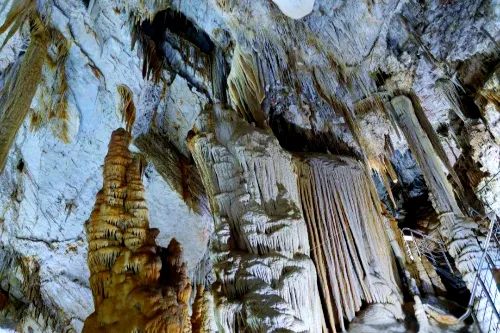
Dragon Palace Hall
Dragon Palace Hall is one of the most spectacular scenic zones in the cave, with an area of about 800 square meters and a maximum height of 20 meters. The zone is filled with stone pillars, among which a main stone pillar is about 15 meters high and 3 meters in diameter, with a pure white body, shaped like a jade pillar in a dragon palace, displaying a magnificent momentum. The surrounding stone curtains hang down like curtains, and the stalagmites stand in formation like divine soldiers. With colorful lights, it feels like entering a legendary undersea dragon palace, hence the name "Dragon Palace Hall".
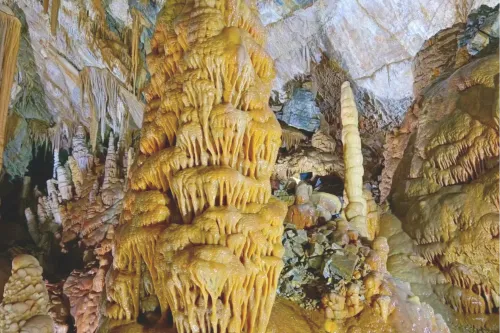
Crystal Curtain
Crystal Curtain is a landscape composed of dense stone curtains located in the middle of the cave. These stone curtains hang from the cave roof, with varying lengths, the longest reaching 8 meters. With a crystal-clear texture, under the light, they look like curtains strung with countless crystals. When a breeze blows (cave airflow), a "ding-dong" sound can be faintly heard, hence the name. This landscape took over 100,000 years to form and is one of the premium landscapes in the cave.
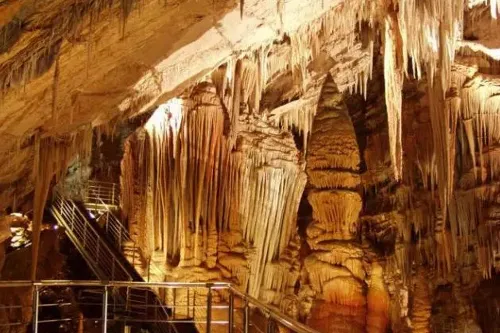
Stone Flower Fairyland
Stone Flower Fairyland features a large area of stone flowers, covering about 500 square meters. Stone flowers are rare landscapes in caves, formed by the condensation of calcite crystals, shaped like petals and stars, with colors ranging from milky white to light yellow. They densely cover the rock walls and stalagmite surfaces, with a total area of about 200 square meters, resembling a sea of flowers in a fairyland, thus named "Stone Flower Fairyland", which has high ornamental and scientific research value.
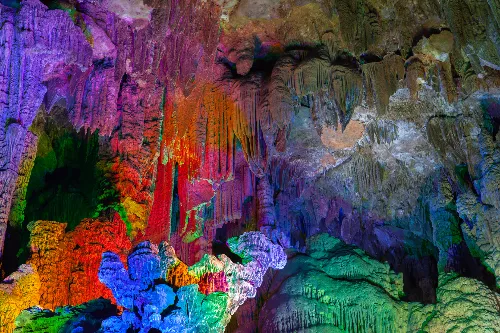
Qingtian Jade Pillar
Qingtian Jade Pillar is one of the iconic landscapes in the cave, located in the second half of the cave, about 18 meters high and 2.5 meters in diameter. It was formed by the gradual connection of stalactites from the cave roof and stalagmites from the ground, taking over 500,000 years to form. The stone pillar is straight with clear textures, like a huge pillar supporting the cave vault, with a majestic momentum, hence the name "Qingtian Jade Pillar".
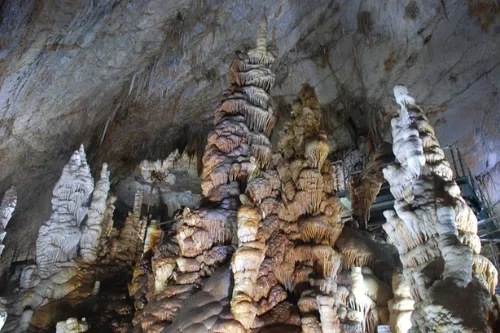
Tour Route
After entering the scenic area, visitors first pass through the entrance square and walk about 200 meters to reach the cave entrance. Upon entering the cave, they follow the designated tour trail to visit the Welcome Hall in sequence (visiting time about 10 minutes) to admire the Welcome Stone and surrounding small landscapes; then enter the Dragon Palace Hall (visiting time about 20 minutes) to focus on the giant stone pillars and dragon palace landscapes; continue forward to the Crystal Curtain (visiting time about 15 minutes) to feel the crystal clarity of the stone curtains; then enter the Stone Flower Fairyland (visiting time about 15 minutes) to observe the rare stone flower landscapes; finally reach the Qingtian Jade Pillar (visiting time about 10 minutes). After viewing the iconic stone pillar, they return to the cave exit along the return trail. The total length of the tour route is about 600 meters, with a visiting time of about 1.5-2 hours. After exiting the cave, visitors can go to the geological science museum in the scenic area (with an area of about 800 square meters) to learn about the geological knowledge of the cave's formation. In total, the visiting time for the entire scenic area is about 3 hours.
Travel Suggestions
- It is recommended to spend half a day (3-4 hours) visiting to fully explore the cave and surrounding facilities.
- The temperature inside the cave remains at 18-20℃ all year round with high humidity. It is advisable to bring a thin coat and wear non-slip shoes.
- The light inside the cave is dim, and some sections are slippery. When walking, pay attention to your steps. It is recommended to follow a guide or the signposts.
- The geological science museum in the scenic area is open for free. It is recommended to visit it after exploring the cave to gain geological knowledge. Its opening hours are the same as the scenic area's.
- The best seasons to visit are spring and autumn, when the surrounding natural scenery is beautiful and the climate is pleasant; summer is good for avoiding the heat, and the cave is warm in winter, both suitable for visiting.
- It is recommended to bring a camera, but note that the use of flash photography is prohibited inside the cave to avoid affecting other visitors and protecting the landscapes.
- There are few catering facilities in the scenic area. It is recommended to bring an appropriate amount of drinking water and snacks and eat in designated rest areas.
Precautions
- The landscapes in the cave are non-renewable geological relics. It is strictly prohibited to touch or knock on stalactites, stalagmites and other landscapes; violators will be punished.
- Smoking and littering inside the cave are prohibited to keep the cave environment clean.
- When visiting, abide by the scenic area regulations and do not deviate from the designated tour trails without permission to avoid danger or damage to undeveloped areas.
- Visitors with children must take good care of them, preventing them from running and climbing to ensure safety.
- Some areas inside the cave are narrow. Pay attention to avoiding other visitors and pass in an orderly manner.
- Visitors with diseases such as heart disease and hypertension should enter the cave cautiously according to their own conditions, as the ventilation inside the cave is limited.
- Obey the management of the scenic area staff and follow the instructions for evacuation in case of emergencies.
Transportation
- Self-driving: Starting from Beijing, drive along Jingping Expressway and Capital Ring Expressway, exit at Xinglong/Banbishan, then drive about 20 kilometers according to the signposts to reach the scenic area. The total distance is about 160 kilometers, with a driving time of about 2.5 hours; starting from Chengde urban area, drive along Daguang Expressway and Capital Ring Expressway, exit at Xinglong, then drive about 15 kilometers to reach the scenic area. The total distance is about 130 kilometers, with a driving time of about 2 hours. The parking fee in the scenic area is 5 yuan per time.
- Long-distance bus: Take a bus from Xinglong County Bus Station to Beishuiquan Township, get off at Taojiatai Village, then walk about 500 meters to the scenic area. Buses run hourly from 6:30 to 16:30 every day, with a fare of 10 yuan per person.
- Tourist special line: There are tourist buses to Xinglong Karst Cave from Beijing Dongzhimen Bus Station and Chengde East Bus Station. In peak season (April-October), there are two departures daily (8:00, 9:00); in off-season (November-March), there is one departure daily (8:30). The driving time is about 3 hours, with a one-way fare of 50 yuan per person.
Opening Hours
The opening hours are slightly adjusted according to the season. In peak season (April 1 - October 31), the opening hours are 8:00-17:30, and the last entry time is 16:30; in off-season (November 1 - March 31 of the next year), the opening hours are 8:30-16:30, and the last entry time is 15:30. The scenic area is open all year round, including holidays. It may be temporarily closed in case of special weather (such as heavy rain, earthquake, etc.). It is recommended to check the official information of the scenic area before traveling.
Tickets
As of August 14, 2025, the ticket price is 100 yuan per person. You can search for the service account "河北承德兴隆溶洞" on WeChat to get the latest updates or buy tickets online.
Online Booking
Click here to jump to the Trip.com ticketing platform for ticket purchase.
